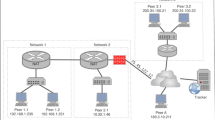Abstract
BitTorrent (bt), a Peer-to-Peer (p2p) distribution system, is a major bandwidth consumer in the current Internet. This paper reports on a measurement study of bt traffic intended to identify potential traffic invariants. To this end, we employ high-accuracy packet capture hardware together with specialized parsing software. Important characteristics regarding bt sessions and messages as well as general system characteristics are reported.
The results indicate that characteristics such as session inter-arrival times are corroborated to be exponentially distributed, while other characteristics are shown to differ from previously reported results. These differences are attributed to changes in the core bt algorithms. Further, it is observed that long- and heavy-tailed distributions can be used to model several characteristics. The log-normal, Pareto and mixtures of these distributions are used to model session sizes and durations, while the Weibull distribution has been observed to model message inter-arrival and inter-departure times for bandwidth-limited clients.
Similar content being viewed by others
References
Cohen, B. (2005). BitTorrent protocol specification.
Erman, D. (2005). BitTorrent traffic measurements and models. Licentiate thesis, Blekinge Institute of Technology.
Erman, D., Ilie, D., & Popescu, A. (2005). BitTorrent session characteristics and models—extended version. To appear in COMCOM special journal issue dedicated to “Performance Modelling and Evaluation of Heterogeneous Networks HET-NETs’05 and HET-NETs’06”.
Ilie, D., & Erman, D. (2007). Peer-to-peer traffic measurements (Technical Report No 2007:02). Blekinge Institute of Technology.
Izal, M. et al. (2004). Dissecting BitTorrent: Five months in a torrent’s lifetime. In Passive and active measurements (PAM2004).
Legout, A., Urvoy-Keller, G., & Michiardi, P. (2005). Understanding BitTorrent: An experimental perspective (Technical report). INRIA Sophia Antipolis/INRIA Rhône-Alpes—PLANETE INRIA France, EURECOM—Institut Eurecom.
Paxson, V., & Floyd, S. (1997) Why we don’t know how to simulate the Internet. In Winter simulation conference (pp. 1037–1044).
Pouwelse, J. A. et al. (2005). The BitTorrent p2p file-sharing system: Measurements and analysis. In 4th international workshop on peer-to-peer systems (IPTPS’05).
Qiu, D., & Srikant, R. J. (2004). Modeling and performance analysis of BitTorrent-like peer-to-peer networks (Technical report). University of Illinois at Urbana-Champaign, USA.
Saavedra, D., Juan, S., & Sánchez González, J.Á. (2006). BitTorrent traffic model extensions. Master’s thesis, Blekinge Institute of Technology.
Saroiu, S., Gummadi, P. K., & Gribble, S. D. (2002). A measurement study of peer-to-peer file sharing systems. In Proceedings of the multimedia computing and networking (MMCN).
Sen, S., & Wang, J. (2004). Analyzing peer-to-peer traffic across large networks. IEEE/ACM Transactions on Networking, 12(2), 219–232.
Author information
Authors and Affiliations
Corresponding author
Rights and permissions
About this article
Cite this article
Erman, D., Saavedra, D., Sánchez González, J.Á. et al. Validating BitTorrent models. Telecommun Syst 39, 103–116 (2008). https://doi.org/10.1007/s11235-008-9115-z
Published:
Issue Date:
DOI: https://doi.org/10.1007/s11235-008-9115-z




